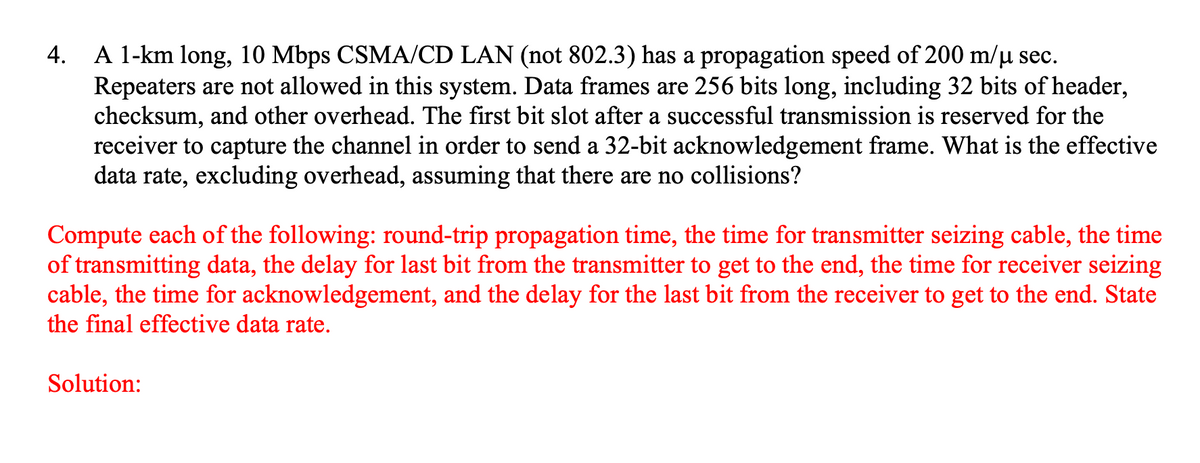A 1-km long, 10 Mbps CSMA/CD LAN (not 802.3) has a propagation speed of 200 m/u sec. Repeaters are not allowed in this system. Data frames are 256 bits long, including 32 bits of header, checksum, and other overhead. The first bit slot after a successful transmission is reserved for the receiver to capture the channel in order to send a 32-bit acknowledgement frame. What is the effective data rate, excluding overhead, assuming that there are no collisions? 4. Compute each of the following: round-trip propagation time, the time for transmitter seizing cable, the time of transmitting data, the delay for last bit from the transmitter to get to the end, the time for receiver seizing cable, the time for acknowledgement, and the delay for the last bit from the receiver to get to the end. State the final effective data rate. Solution:
A 1-km long, 10 Mbps CSMA/CD LAN (not 802.3) has a propagation speed of 200 m/u sec. Repeaters are not allowed in this system. Data frames are 256 bits long, including 32 bits of header, checksum, and other overhead. The first bit slot after a successful transmission is reserved for the receiver to capture the channel in order to send a 32-bit acknowledgement frame. What is the effective data rate, excluding overhead, assuming that there are no collisions? 4. Compute each of the following: round-trip propagation time, the time for transmitter seizing cable, the time of transmitting data, the delay for last bit from the transmitter to get to the end, the time for receiver seizing cable, the time for acknowledgement, and the delay for the last bit from the receiver to get to the end. State the final effective data rate. Solution:
Operations Research : Applications and Algorithms
4th Edition
ISBN:9780534380588
Author:Wayne L. Winston
Publisher:Wayne L. Winston
Chapter20: Queuing Theory
Section20.10: Exponential Queues In Series And Open Queuing Networks
Problem 8P
Related questions
Question

Transcribed Image Text:A 1-km long, 10 Mbps CSMA/CD LAN (not 802.3) has a propagation speed of 200 m/µ sec.
Repeaters are not allowed in this system. Data frames are 256 bits long, including 32 bits of header,
checksum, and other overhead. The first bit slot after a successful transmission is reserved for the
receiver to capture the channel in order to send a 32-bit acknowledgement frame. What is the effective
data rate, excluding overhead, assuming that there are no collisions?
4.
Compute each of the following: round-trip propagation time, the time for transmitter seizing cable, the time
of transmitting data, the delay for last bit from the transmitter to get to the end, the time for receiver seizing
cable, the time for acknowledgement, and the delay for the last bit from the receiver to get to the end. State
the final effective data rate.
Solution:
Expert Solution
This question has been solved!
Explore an expertly crafted, step-by-step solution for a thorough understanding of key concepts.
This is a popular solution!
Trending now
This is a popular solution!
Step by step
Solved in 2 steps with 1 images

Knowledge Booster
Learn more about
Need a deep-dive on the concept behind this application? Look no further. Learn more about this topic, computer-science and related others by exploring similar questions and additional content below.Recommended textbooks for you

Operations Research : Applications and Algorithms
Computer Science
ISBN:
9780534380588
Author:
Wayne L. Winston
Publisher:
Brooks Cole

Systems Architecture
Computer Science
ISBN:
9781305080195
Author:
Stephen D. Burd
Publisher:
Cengage Learning

Principles of Information Security (MindTap Cours…
Computer Science
ISBN:
9781337102063
Author:
Michael E. Whitman, Herbert J. Mattord
Publisher:
Cengage Learning

Operations Research : Applications and Algorithms
Computer Science
ISBN:
9780534380588
Author:
Wayne L. Winston
Publisher:
Brooks Cole

Systems Architecture
Computer Science
ISBN:
9781305080195
Author:
Stephen D. Burd
Publisher:
Cengage Learning

Principles of Information Security (MindTap Cours…
Computer Science
ISBN:
9781337102063
Author:
Michael E. Whitman, Herbert J. Mattord
Publisher:
Cengage Learning